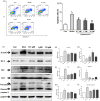Huperzine A attenuates nonalcoholic fatty liver disease by regulating hepatocyte senescence and apoptosis: an in vitro study
- PMID: 29967757
- PMCID: PMC6025153
- DOI: 10.7717/peerj.5145
Huperzine A attenuates nonalcoholic fatty liver disease by regulating hepatocyte senescence and apoptosis: an in vitro study
Abstract
Objective: This study was undertaken to detect if free fatty acids (FFA) induce hepatocyte senescence in L-02 cells and if huperzine A has an anti-aging effect in fatty liver cells.
Methods: L-02 cells were treated with a FFA mixture (oleate/palmitate, at 3:0, 2:1, 1:1, 1:2 and 0:3 ratios) at different concentrations. Cell viability and fat accumulation rate were assessed by a Cell Counting Kit 8 and Nile Red staining, respectively. The mixture with the highest cell viability and fat accumulation rate was selected to continue with the following experiment. The L-02 cells were divided into five groups, including the control group, FFA group, FFA + 0.1 μmol/L huperzine A (LH) group, FFA + 1.0 μmol/L huperzine A (MH) group and FFA + 10 μmol/L huperzine A (HH) group, and were cultured for 24 h. The expression of senescence-associated β-galactosidase (SA-β-gal) was detected by an SA-β-gal staining kit. The expression levels of aging genes were measured by qRT-PCR. The expression levels of apoptosis proteins were detected by a Western blot. ELISA kits were used to detect inflammatory factors and oxidative stress products. The expression of nuclear factor (NF-κB) and IκBα were detected by immunofluorescence.
Results: The FFA mixture (oleate/palmitate, at a 2:1 ratio) of 0.5 mmol/L had the highest cell viability and fat accumulation rate, which was preferable for establishing an in vitro fatty liver model. The expression of inflammatory factors (TNF-α and IL-6) and oxidants Malonaldehyde (MDA), 4-hydroxynonenal (HNE) and reactive oxygen species (ROS) also increased in the L-02 fatty liver cells. The expression levels of aging markers and aging genes, such as SA-β-gal, p16, p21, p53 and pRb, increased more in the L-02 fatty liver cells than in the L-02 cells. The total levels of the apoptosis-associated proteins Bcl2, Bax, Bax/Bcl-2, CyCt and cleaved caspase 9 were also upregulated in the L-02 fatty liver cells. All of the above genes and proteins were downregulated in the huperzine A and FFA co-treatment group. In the L-02 fatty liver cells, the expression of IκBα decreased, while the expression of NF-κB increased. After the huperzine A and FFA co-treatment, the expression of IκBα increased, while the expression of NF-κB decreased.
Conclusion: Fatty liver cells showed an obvious senescence and apoptosis phenomenon. Huperzine A suppressed hepatocyte senescence, and it might exert its anti-aging effect via the NF-κB pathway.
Keywords: Apoptosis; Hepatocyte senescence; Huperzine A; Nonalcoholic fatty liver disease.
Conflict of interest statement
The authors declare that they have no competing interests.
Figures





Similar articles
-
The anti-inflamm-aging and hepatoprotective effects of huperzine A in D-galactose-treated rats.Mech Ageing Dev. 2013 Mar;134(3-4):89-97. doi: 10.1016/j.mad.2012.12.005. Epub 2013 Jan 8. Mech Ageing Dev. 2013. PMID: 23313706
-
Intervention effect of Cigu Xiaozhi prescription on ceramide lipoapoptosis in non-alcoholic fatty liver disease.J Tradit Chin Med. 2024 Feb;44(1):63-69. doi: 10.19852/j.cnki.jtcm.20231215.002. J Tradit Chin Med. 2024. PMID: 38213240 Free PMC article.
-
[Urolithin A inhibits inflammation and oxidative stress induced by high lipid in hepatocytes via activating Nrf2 pathway and autophagy].Xi Bao Yu Fen Zi Mian Yi Xue Za Zhi. 2021 Nov;37(11):973-980. Xi Bao Yu Fen Zi Mian Yi Xue Za Zhi. 2021. PMID: 34809736 Chinese.
-
Active vitamin D supplementation alleviates initiation and progression of nonalcoholic fatty liver disease by repressing the p53 pathway.Life Sci. 2020 Jan 15;241:117086. doi: 10.1016/j.lfs.2019.117086. Epub 2019 Nov 20. Life Sci. 2020. PMID: 31756344
-
[Lycopene ameliorates D-galactose-induced hepatic senescence in CD-1 female mice through fibroblast growth factor 21/mitochondrial dynamics mediation].Wei Sheng Yan Jiu. 2025 Mar;54(2):265-272. doi: 10.19813/j.cnki.weishengyanjiu.2025.02.014. Wei Sheng Yan Jiu. 2025. PMID: 40355334 Chinese.
Cited by
-
A Synopsis of Multitarget Potential Therapeutic Effects of Huperzine A in Diverse Pathologies-Emphasis on Alzheimer's Disease Pathogenesis.Neurochem Res. 2022 May;47(5):1166-1182. doi: 10.1007/s11064-022-03530-2. Epub 2022 Feb 5. Neurochem Res. 2022. PMID: 35122609 Review.
-
The p66shc-mediated Regulation of Hepatocyte Senescence Influences Hepatic Steatosis in Nonalcoholic Fatty Liver Disease.Med Sci Monit. 2020 Mar 19;26:e921887. doi: 10.12659/MSM.921887. Med Sci Monit. 2020. PMID: 32191680 Free PMC article.
References
LinkOut - more resources
Full Text Sources
Other Literature Sources
Research Materials
Miscellaneous

